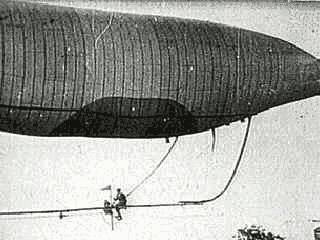The California Eagle
Today, America finally manages to fly a dirigible. The University of Houston's College of Engineering presents this series about the machines that make our civilization run, and the people whose ingenuity created them.
America lagged far behind Europe in inventing the dirigible. Our early airship attempts were concentrated in our still primitive West. The dream of flight fitted the restless migrant mind, but it foundered in the roughhewn technology of a new land. In other episodes we talk about failed efforts to fly dirigibles between California and New York. Yet, in the end, our first successful dirigible flights actually were made in San Francisco.
Two dirigibles compete for priority. The first was Dr. August Greth's California Eagle. Greth came to America from Europe with some knowledge of early French airships. He formed a company to build a dirigible in San Francisco in 1897.
It took him six years to build the California Eagle -- an 80-foot hydrogen-filled sausage. Its two propellers were driven by an early 12 HP automobile engine. The engine weighed 500 pounds. He first sent his dirigible up over Market Street on a tether cable at summer's end in 1903. He was ready for free flight in October -- 2 months before the Wright Brothers flew.
He buoyed 2000 feet into a gray morning sky and flew about the city. Then the sun burned away the overcast and began to heat the gas bag. While he struggled to maintain altitude by venting hydrogen, his motor died. He finally ditched safely into the cold waters of San Francisco Bay.
A year later a daredevil named Scott Baldwin entered the scene. Baldwin was an exhibition balloonist. In 1887 he'd parachuted from a balloon over Golden Gate Park on a deal that paid him a dollar a foot for his leap. He collected $3000.
He built a lighter dirigible than Greth had. Powered by a motorcycle engine with one propeller, it was not only smaller but less sophisticated as well. He called it the California Arrow, and it first took to the air over Oakland, California -- 9 months after Greth's flight and 7 months after the Wright Brothers'.
Baldwin's flight was modest. He climbed only 500 feet. But it was an unvarnished success. He repeated it two days later and then took his airship off to win prizes at the St. Louis Fair. He finally sold the machine to the German Imperial Army.
I'd give the crown to Greth, even if he did land in the Bay. Beyond being first, he'd produced the more innovative and controllable airship. Baldwin had to walk back and forth along the length of his dirigible to control its pitch. Baldwin's edge over Greth lay in his access to a better, lighter engine. With the new internal combustion engines in hand, all kinds of people were suddenly able to do what had so recently seemed impossible.
I'm John Lienhard, at the University of Houston, where we're interested in the way inventive minds work.
(Theme music)
Kurtz, G.F., 'Navigating the Upper Strata' and the Quest for Dirigibility. California History, Vol. LVIII, No. 4, Winter 1978/9, pp. 334-347.

(clipart)
An unidentified photo of what might be Greth's dirigible -- certainly of one that is similar in style.